Impromptu — unrehearsed, unscripted, unprepared — such is the spirit of Paul Lee’s (李皞) eponymous restaurant. Tucked behind the luxury backdrop of the Regent Taipei Hotel (台北晶華酒店), Impromptu offers a clean swanky aesthetic.
Opened in August 2018, Impromptu quickly picked up one Michelin star. The secret behind its swift success is not only innovative cuisine, but the concept and holistic experience.
Impromptu first attraction is the open kitchen. Upon entering, every guest makes eye contact with the chef team. Without the kitchen-to-table separation, every guest can observe as the dishes come together, or on the rare occasion, fall apart. Whether it be rejoicing together at a perfectly executed dish or face-palming at an overcooked egg, chef and guest are allowed to truly bond. For this reason I highly recommend sitting at the bar.
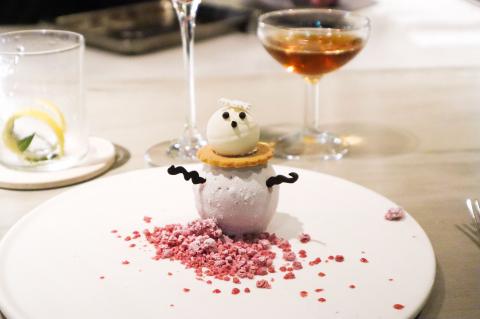
Photo: George Lee
Borrowed from the Japanese dining concept Omakase, Chef Lee’s vision entails a dining experience where guests give chefs complete creative freedom to design their meal. His restaurant has neither a menu, nor a wine list. It is this level of spontaneity that encapsulates the dining experience at Impromptu — you never know what new trick the chef will pull out of his hat.
For the full experience, I went with their Christmas tasting menu and cocktail pairing (prices vary depending on the season). The degustation begins with scallop and crown daisy wrapped in a thin daikon veil, topped with chorizo and altogether lie atop a bed of seashells and rocks. I picked it up with my fingers and ate it like it is a piece of sushi. The briny fragrance of the scallop coupled with the salty chorizo and daikon made the dish a little on the salty side; I would have preferred to eat each constituent ingredient on its own. I laud the effort to marry these salty ingredients though — they whetted my appetite.
Up next were bite-sized glutinous tapioca balls stuffed with porcini and salted pork. I sunk my teeth into its crunchy outer layer without much care, only to be surprised by the soft mochi-like interior. The contrasting textures really stood out to me; I chewed for a few extra seconds, puzzled by the salty and earthy flavors, which usually are not paired with the chewy, gummy dough. At the end of the one-biter I was only partially convinced that the combination worked.
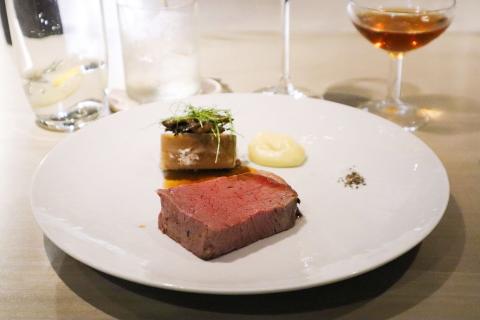
Photo: George Lee
Then came “Eric’s daily bao tang,” a velvety rich broth topped with various herbs. As I sipped the broth, I felt it travel down my throat and warming the rest of my body, making me feel oddly awake in the restaurant’s dimly lit ambiance. The silky and creamy broth reminded me of chicken concentrate my grandmother used to drink, almost forgetting that I was sitting in a Michelin-starred restaurant.
Things picked up with the next dish: a cloud of lemon verbena egg-white foam over slices of raw hamachi and strawberry. The consistency of the foam was light and airy; the hints of citrus and spice from magao, a mountain pepper, came together nicely. The bracing acidity and sweetness of the strawberry surprisingly elevated the mild buttery flavor of the fish. Traces of French influence is unambiguous here with the seafood-fruit pairing.
A kind of interlude was the house-made bread and whipped butter. Just the right amount of charring on the outside and delicate, flecked with grains on the inside — perfectly baked, but slightly boring.
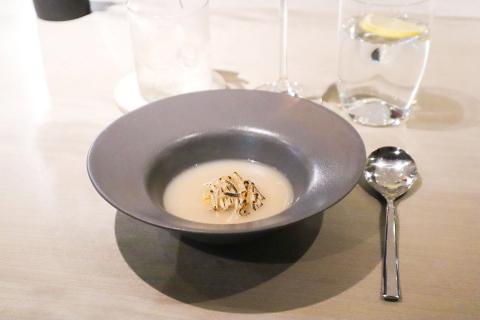
Photo: George Lee
As I imbibed their delicious alcoholic cocktails, I watch the chefs prepare rice broth with seaweed, abalone and torched enoki mushrooms. The viscosity of the broth was similar to the “bao tang” but the piscine abalone and earthy mushroom gave it an extra dimension of flavor.
This was followed by noodles tossed with lobster chunks and burnt scallions in a tangy lobster-bisque reduction, a highlight in terms of creativity and taste. It made me picture myself slurping the same bowl of noodles at a local noodle shop. Then there was the thin-crust cheese pizza with hunan sausage and sliced black truffle, which ran so sinfully cheesy and luscious. Perhaps this is Chef Lee’s specialty: his choice of ingredients and techniques is sometimes so incongruous it transports you to different culinary universes.
The main course, too, spun off a fine-dining staple: a slab of medium-rare beef rib-eye, bone marrow topped by sauteed mushrooms and a small helping of puree potatoes. The bone marrow, on the verge of melting at room temperature, exuded a nutty, beefy richness, offsetting the low-fat rib-eye cut. The puree potatoes were flawlessly executed as well; they were appropriately moist and buttery.
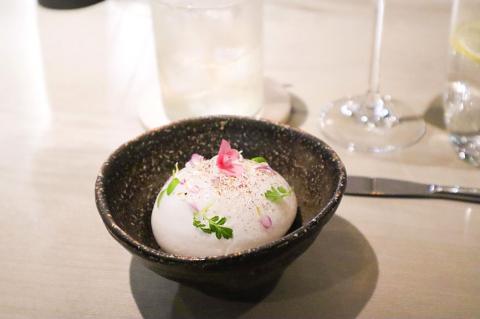
Photo: George Lee
The snowman dessert looked as good as it tasted. As the plate hits the table, the chef ladles liquid nitrogen-infused ruby chocolate and vapors consume the snowman like it is its own microcosm. When you savagely pry open the body of the snowman, you find more ruby chocolate that encases yogurt parfait and a molten peach coulis core. Perfumed by the tart peach, the subtle fruitiness of the ruby chocolate is elevated instead of overpowered. Different layers of the dessert confer different flavors, and different textures dance on my tongue, waltzing to a crescendo.
Such is the spirit of Impromptu: guests are meant to be surprised by Paul Lee’s daring spontaneity. His adroit manipulation of both the dining space and the food space deserves recognition.
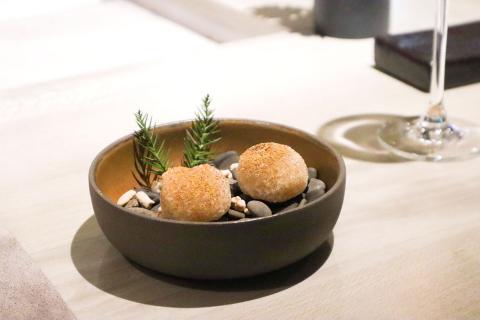
Photo: George Lee

April 14 to April 20 In March 1947, Sising Katadrepan urged the government to drop the “high mountain people” (高山族) designation for Indigenous Taiwanese and refer to them as “Taiwan people” (台灣族). He considered the term derogatory, arguing that it made them sound like animals. The Taiwan Provincial Government agreed to stop using the term, stating that Indigenous Taiwanese suffered all sorts of discrimination and oppression under the Japanese and were forced to live in the mountains as outsiders to society. Now, under the new regime, they would be seen as equals, thus they should be henceforth

Last week, the the National Immigration Agency (NIA) told the legislature that more than 10,000 naturalized Taiwanese citizens from the People’s Republic of China (PRC) risked having their citizenship revoked if they failed to provide proof that they had renounced their Chinese household registration within the next three months. Renunciation is required under the Act Governing Relations Between the People of the Taiwan Area and the Mainland Area (臺灣地區與大陸地區人民關係條例), as amended in 2004, though it was only a legal requirement after 2000. Prior to that, it had been only an administrative requirement since the Nationality Act (國籍法) was established in

Three big changes have transformed the landscape of Taiwan’s local patronage factions: Increasing Democratic Progressive Party (DPP) involvement, rising new factions and the Chinese Nationalist Party’s (KMT) significantly weakened control. GREEN FACTIONS It is said that “south of the Zhuoshui River (濁水溪), there is no blue-green divide,” meaning that from Yunlin County south there is no difference between KMT and DPP politicians. This is not always true, but there is more than a grain of truth to it. Traditionally, DPP factions are viewed as national entities, with their primary function to secure plum positions in the party and government. This is not unusual

US President Donald Trump’s bid to take back control of the Panama Canal has put his counterpart Jose Raul Mulino in a difficult position and revived fears in the Central American country that US military bases will return. After Trump vowed to reclaim the interoceanic waterway from Chinese influence, US Defense Secretary Pete Hegseth signed an agreement with the Mulino administration last week for the US to deploy troops in areas adjacent to the canal. For more than two decades, after handing over control of the strategically vital waterway to Panama in 1999 and dismantling the bases that protected it, Washington has